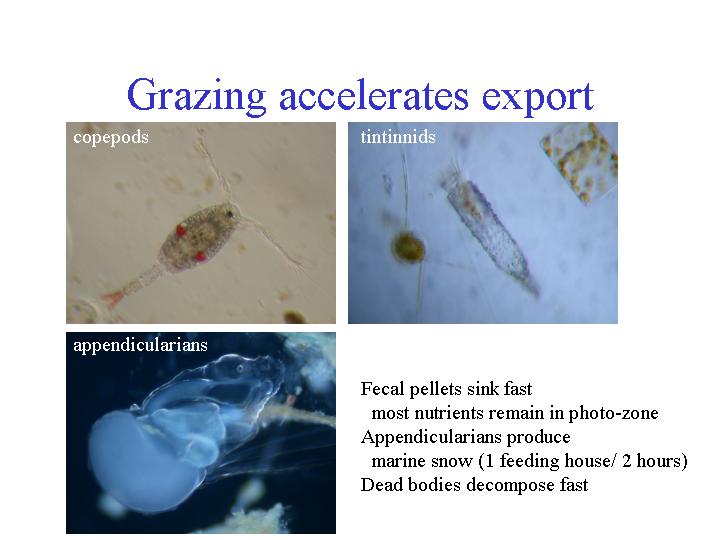Cpump: NWO-program on Computational Life Sciences
Understanding the 'organic carbon pump' in meso-scale ocean flows
Drs. J. Bruggeman,
Drs. A. W. Omta,
Ir. M. H. van Raalte,
Prof. Dr. S. A. L. M. Kooijman ,
Dr. B. W. Kooi,
Prof. Dr. H. A. Dijkstra,
Dr. B. P. Sommeijer
Algae require light, carbon dioxide (from the atmosphere) and
nutrients (nitrate, phosphate, iron) for growth. When they sink out of
the relatively warm, nutrient-poor, light-rich mixed-layer they die,
are partially degraded, and intra-cellular nutrients are released. An
increase in wind causes an increase in the depth of the mixed-layer
and part of the exported nutrients return to the mixed-layer. The
partially degraded organic matter further sinks to the deep ocean;
this process is accelerated by grazing. High winds give deep mixing
layers (so low average light levels for the algae) and relatively low
temperatures (which go with low physiological rates). The proximate
control of production is by wind, the ultimate control by nutrients.


This research project aims to quantify the rate at which algae
bind carbon dioxide, by implementing a DEB-based model for algal growth in a basin
circulation model, using advanced numerical techniques. We hope to
understand observed chlorophyll patterns in the oceans from first
principles.


Posters
- Bruggeman, J. 2005/02/25
Modeling the biological carbon pump.
NWO-Computational Life Sciences, Utrecht
- Bruggeman, J. 2005/06/27
Trait-based models to capture biodiversity:
the phytoplankton test case
Advances in Marine Ecosystem Modelling Research.
(AMEMR) symposium, Plymouth UK
- Omta, A.-W. 2005/02/25
The impact of geophysical turbulence on three-dimensional plankton
distribution patterns.
NWO-Computational Life Sciences, Utrecht
- Omta, A.-W. 2006/04/04
Feedback mechanisms between climate and the Redfield ratio,
European Geosciences Union (EGU) General Assembly, Vienna, Austria
- Omta, A.-W. 2007/11/28
Critical turbulence revisited,
European Conference on Ecological Modelling (ECEM), Trieste, Italy
Presentations
- Bruggeman, J. 2004/12/09
Quantifying the organic carbon pump.
Host: Hans Burchard,
Institut für Ostseeforschung Warnemünde,
Warnemünde, Germany
- Bruggeman, J. 2005/03/04
Trait-based models for functional groups.
Meeting: Dutch Association for Theoretical Biology,
Schoorl, The Netherlands
- Bruggeman, J. 2005/03/22
Integration schemes for biochemical systems: unconditional
positivity and mass conservation.
Host: Andreas Meister, Kassel University, Kassel, Germany
- Bruggeman, J. 2005/04/06
Integration schemes for biochemical systems: unconditional
positivity and mass conservation.
Meeting: International Council for the Exploration of the Sea (ICES),
WGPBI workgroup, Numerical Modelling SubGroup.
University of Hamburg, Hamburg, Germany
- Bruggeman, J. 2005/09/27
Accounting for biodiversity in marine ecosystem models.
Host: Kai Wirtz, GKSS Forschungszentrum, Geesthacht, Germany
- Omta, A.-W. 2005/03/04
The interplay between eddies and biota in the ocean.
Meeting: Dutch Association for Theoretical Biology,
Schoorl, The Netherlands
- Omta, A.-W. 2005/10/26
How does the `organic carbon pump' determine the equilibrium
CO2 concentration in the atmosphere?
IMAU, Utrecht, the Netherlands
- Bruggeman, J. 2006/04/06
A biodiversity-inspired approach to aquatic ecosystem modelling.
Meeting: International Council for the Exploration of the Sea (ICES),
WGPBI workgroup. IFREMER, Nantes, France
- Bruggeman, J. 2006/06/01
A biodiversity-inspired approach to aquatic ecosystem modelling.
Host: Uffe Thygesen, Danish Institute for Fisheries Research,
Copenhagen, Denmark
- Bruggeman, J. & Omta, A.-W. 2006/09/04
A biodiversity-inspired approach to aquatic ecosystem modelling.
Host: Andreas Oschlies.
Kiel, Germany
- Bruggeman, J. 2006/10/17
A biodiversity-inspired approach to aquatic ecosystem modelling.
Host: Ecosystem Modeling/KOE, GKSS Forschungszentrum,
Geesthacht, Germany
- Omta, A.-W. 2006/03/02
The physics of the biological carbon pump.
Dutch Association for Theoretical Biology (NVTB), Schoorl, The Netherlands
- Bruggeman, J. 2007/03/26
From species to traits: biodiversity-inspired ecosystem models,
International Council for the Exploration of the Sea (ICES), WGPBI workgroup.
Bergen, Norway
- Bruggeman, J. 2007/05/10
Succession in a water column: An adapting ecosystem
maneuvering between autotrophy and heterotrophy.
Dutch Association for Theoretical Biology (NVTB), Schoorl, The Netherlands
- Bruggeman, J. 2007/11/05
Adapting ecosystem models for aquatic systems.
Host: Andreas Oschlies, IfM-GEOMAR. Kiel, Germany
- Bruggeman, J. 2007/11/13
Trait distributions as basis for ecosystem models:
interpretation, strengths & caveats.
German Advances in Marine Ecosystem Modeling (GAMEM). Hamburg, Germany
- Bruggeman, J. 2007/11/29
An adapting, trait-based ecosystem model for phytoplankton succession.
European Conference on Ecological Modelling (ECEM). Trieste, Italy
- Omta, A.-W. 2007/04/18
The impact of (sub-)mesoscale eddies on the soft-tissue carbon pump.
European Geosciences Union (EGU) General Assembly, Vienna, Austria
- Omta, A.-W.
2008/09/02, Andreas Oschlies, Kiel;
2008/09/04, Viktor Brovkin, Hamburg, Zentrum fuer Marine und
Atmosphaerische Wissenschaften;
2008/09/05, Andrey Ganopolski, Potsdam, Institut fuer Klimaforschung.
Critical turbulence revisited: the impact of submesoscale vertical
mixing on phytoplankton patchiness.
- Omta, A.-W.
2008/03/13 NIOZ, Texel;
2008/05/30 Oldenburg.
How to interpret satellite chlorophyll observations: a case study about
the Mozambique Channel.
Projects of related interest
Go to projects' entry





